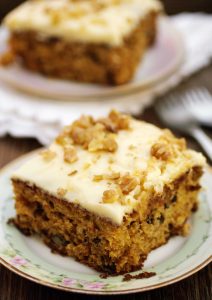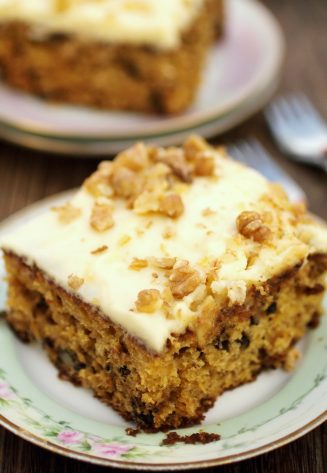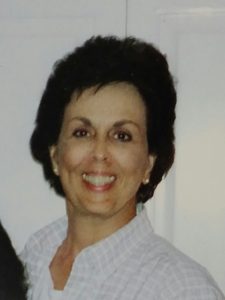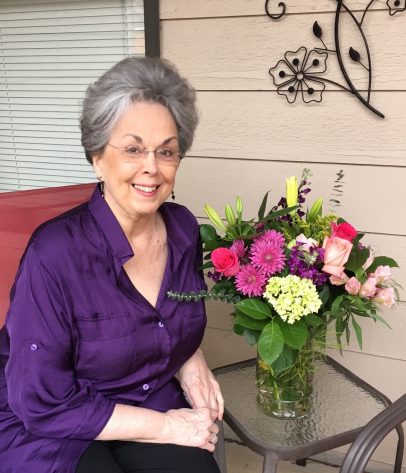Aunt Peggy’s Bestever Cake
The cake above is not just any cake—it’s not even just the bestever cake, it is the last thing I ate prepared by my late aunt Peggy. I got news of her sudden and unexpected death a few weeks ago. That night as I lay sleepless, recalling her, I remembered that she’d made this excellent cake for our family reunion, in June of 2015. She called it simply “bestever cake” and said it was ridiculously simple to make.
More memories of Peggy Jo Rose and her cooking flooded back. On a summer morning when I was eleven or so, Aunt Peggy gave me and my cousins a great gift: encouragement to go out into the world to do some work, with daring, if needed, in order to return home to enjoy the fruits of your labor.
“If you kids go pick sour cherries from Mr. X’s tree, I’ll make you a pie. Remember to ask him first. And pick a big bagful—I’ll need a lot for a pie.”
A pie in exchange for picking cherries was more than fair. We ran off to ask Mr. X ourselves, to figure out how to get up and down the tree ourselves, and to not neglect our work, if we wanted enough fruit for a large, mile-high pie.
We did get that pie, and it was the best pie I’ve ever eaten. Looking back, harvesting those cherries was my first glimpse into how satisfying it is to be a part of the magical transformation of food, hands-on, from the gathering of the raw ingredient to a from-scratch pie made with love and eaten with gratitude.
(Reminiscing with my cousins in the week following Peggy’s death, I learned that that cherry pie was just one of many Peggy made with fruit picked from trees in the neighborhood. Peggy’s pie promise extended to apples, plums, whatever was available and in season, and her children were willing to pick.)
Peggy’s younger daughter, Erin Michelle, is just a year older than me and, growing up, we were close cousins. I stayed overnight with Erin at Aunt Peggy’s off and on for years. We shared lots of hearty breakfasts of eggs or pancakes, but my favorite breakfast memories at Peggy’s involved the simplest of foods, the do-it-yourself breakfasts we made in a rush because we wanted to get outside and explore the day. In summer, we made thick-sliced tomato sandwiches with plump red beauties picked from Peggy’s backyard garden. Salted and laid between two slices of mayonnaise-slathered white toast, nothing was more delicious. A year-round kids-can-cook stand-by was cinnamon-sugar toast. The toast was buttered with a stick of Fleischmann’s designated for this purpose. Hand-held and upended, its foil wrapper peeled back to expose one end, we’d slather the toast with the margarine, getting as many toast crumbs on the “butter” as we got “butter” on the toast. To me, this was renegade. (At my house, we kept our stick of Fleischmann’s in a butter dish and we applied it with a knife.)
By necessity, Peggy embraced the Methodist work ethic she was raised up in. The middle child of five, she stepped in at 14 as cook and caregiver for her younger brother and sister when her single mother pulled long nursing shifts. Probably, that was when she learned to make her famously good fried chicken and to operate a sewing machine like a pro. The skills she picked up during those years as surrogate mom came in handy when, as the fifties segued into the sixties, she became a young wife and mother, eventually raising four children of her own.
To help support her family, Peggy waited tables. Her first job was at The Lamp Post, a 24-hour diner on Market Street in Akron, where she was born and lived for her the first 43 years of her life. She took an 11 pm to 7 am shift; only by that late hour in the evening could she safely rely on her husband to return home to be with their children.
I recall Peggy getting ready for work. She’d be in the pink-tiled bathroom, wearing her black-and-white uniform, doing up her hair and face before heading out into the night in her green Pontiac, and there’d we be, running in to brush our teeth and say a few words before heading off to bed.
Sometimes I didn’t run right out. I’d pause, mesmerized by the transformation in the large bathroom mirror. Peggy was an artist with make-up. Like Bob Ross at the canvas, she made it look so easy: just a deft brushing on if this, and a deft penciling on of that. She knew just what to do to accent her features, and how to create, when she finished, a stunning effect.
First, she laid a foundation to create an even skin tone. She used a pencil to define her arched eyebrows, and black eyeliner and gray-brown eye shadow to emphasize her big brown eyes and give them a dramatic, smoky look. She used what looked like a torture device—a metal eye lash curler—to lift and curl her lashes, and then brushed them with mascara to thicken and lengthen them further. Finally, a touch of color was added to her high cheek bones and to her lips.
She set her wavy jet black hair in curlers and ratted it at the top, adding more height to her full-figured 5’10” frame. To keep every hair in place during the bustling night ahead, she used brain-cell-killing amounts of Aqua Net hair spray. The spell was broken; I always ran from the room, gagging. Eventually, I learned to listen for the rattling sound of Peggy shaking the large aerosol can. Except, unlike Pavlov’s dogs, I’d run away from, instead of toward, the sound, escaping the cough-inducing cloud just in time.
Peggy’s work—unique to her and done deep into the night and in a place I had no conception of—was an alluring mystery to me. Her sewing, in contrast, was in plain sight, spread out on the only work space available—the large Formica table in the kitchen. There she worked on various projects, from clothing to any number of ingenious craft work created with fabric and thread. She didn’t just sew to save money and to clothe her long-limbed children (off-the-rack pants long enough for my cousin Erin didn’t exist), but also to give her children nice things, special things—from custom-made outfits for Holly Hobby dolls to prom dresses. Sewing was work, but I sensed she enjoyed it, and even lost herself in it.
When her projects commandeered the kitchen table at lunchtime, Erin and I enjoyed our midday bologna sandwiches and potato chips al fresco, on the front stoop. From there we surveyed our domain: the wooded hillside lot across the street where we built our forts, scuffed our knees, dirtied our clothes, and regained our appetites. If Peggy’s projects spilled over into dinnertime, we took our homemade meal of meatloaf or fried chicken or spaghetti and meatballs to the living room and ate on folding dinner trays in front of the T.V.
Peggy wasn’t all work all the time, though. She knew how to enjoy herself, as she could and when she could, relishing each of those prized moments. Eventually, when her kids were grown and she had more time, she went to the movies often and read all kinds of books. During the work-intensive years of the late sixties, seventies, and early eighties, though, music was her main entertainment—probably because she could continue to work while she listened. She spun LP’s on the stereo console in the living room, singing along to Three Dog Night, Earth, Wind, & Fire, Herb Alpert & the Tijuana Brass, and, especially, Tom Jones.
By the nineties, she was into the calming and ethereal music of the singer-songwriter known as Enya. This I discovered while riding in her car to go see “A River Runs Through It” with her in Naples, Florida, where she had relocated in the mid-eighties to start afresh and be near her mother and sister, Louanne, my mother. She liked to get to the movies early, so broke the speed limit a little so she’d have time to buy popcorn, even though it was a late afternoon showing, right before dinnertime.
“You get popcorn?” I asked. I was in my late twenties then, still not cured of an inherited unhealthy obsession with “healthy” eating and counting calories in my head.
“Of course. Don’t you?” Not quite my age now, she was feeling her oats, living a brand-new life, free of a long outworn marriage and the need to support her children. By sheer determination and confidence of her innate design sense, she’d made the leap from waiting tables to working in Barley’s Paint & Wallpaper store, and eventually, by the third or fourth position later, was working as a consultant and interior designer in a design center. Instead of delivering plates of food to restaurant customers as she’d done for years in Akron, she was finally using her creative vision to pay the bills.
Last year, sometime around my and Peggy’s birthdays—they were only a few days apart—she and I spoke on the phone. I told her I’d received unsolicited invitations from the American Association of Retired Persons for at least year, even though I’m nowhere near retirement.
She laughed heartily, and in disbelief.
“I can’t believe it,” she said. “Our little Holly is wanted by the AARP? Our little Holly—?”
Peggy’s subtle sarcasm and occasional black humor was lost on me as a child, but I grew to appreciate them as an adult. Come to think of it, Peggy’s humorous remarks were made as much to amuse herself as others, because her own laughter always accompanied them. This is a valuable trait: to know how to amuse yourself, to keep life lighter. There are so many more qualities of Peggy I could tell you about—how didn’t suffer fools easily (naturally, there are no fools in our family) and was fiercely loyal to family and loving to each and every one of us cousins.
Musing over what made Peggy Peggy has made me thankful for her, and all my aunts and uncles, each one different from the other, for showing me other ways of being, of facing adversity, of living life. Her death has brought home to me that with Peggy now gone, a bit of myself, my childself mirrored in her eyes, is gone forever, as is the chance to ask her what her hopes and dreams were. In the aunt and niece relationship, so often the asking the asking of those questions is all in one direction.
* * * * * * * * * * * * * * * * * * * * * * * * *
A few days after losing Peggy, I participated in a one-hour writing workshop called “Life in Ten Minutes.” Twelve of us, strangers to one another, plus the teacher, Valley Haggard, crammed ourselves into a small room at the Midlothian Library, as part of the second annual Festival of the Written Word. Valley gave us a writing prompt and set the timer. Six minutes later, the buzzer went off. Because Valley wanted to give us two prompts plus time to share, the exercises became “Life in Six Minutes,” and “Life in Five Minutes.”
When I read what I’d written to answer the prompt “Right now I’m thinking about . . . ,” I got through the first sentence and couldn’t continue. The subject I wrote so freely about in six minutes in words but I could not speak without tears drowning them was the death of my dear aunt Peggy—still so new and on the surface of my heart.
The gentleman to my left kindly took over the reading for me. When our suddenly intimate group dispersed, a woman sitting by the door raised her hand and gave me a high-five of encouragement.
But I could make cake. And that is what I did. I dug out Peggy’s recipe for the Bestever cake that she’d sent me not long after the family reunion. It was just as good as I remembered it. I took the cake, and a draft of this essay and the recipe, to a writing class. Though the essay needed more work, the teacher, Deirdre McAfee, and my classmates all deemed the cake perfect as it was. As it turned out, that day was my teacher’s husband’s birthday. I sent her home with a large portion of cake, which had, my teacher later reported, impressed and delighted her “birthday boy.” Not only am I, and all of my family members, thankful for Peggy, now a complete stranger is, too. Always generous, I’m sure Peggy would have happily shared a slice of her cake with a stranger on his birthday, and wished him the best ever birthday, too.
Afterword:
This Thanksgiving Day posting was written in thanks for the life of my Aunt Peggy, who left this earth, with all its pleasures and pains, on November 1, at the age of seventy-four. She was a warm and generous person who always thought of others first. It’s hard to believe she is gone, one of five aunts and uncles who form the bedrock of my mother’s side of the family. I hope the memories I’ve shared convey some of Peggy’s spirit, and give some comfort to my cousins this Thanksgiving, their first without their mom.
Peggy’s Bestever Cake Recipe
 This cake is like my Aunt Peggy. She was practical and she liked to enjoy life. This recipe is nothing but practical—the only way it could be more so is if you were to use a boxed cake mix (and who would want to do that). The cake is moist, dense, and flavorful, in a word, enjoyable and then some. Though crushed pineapple is a key ingredient, the cake doesn’t taste particularly pineapple-y. The prominent flavor is of walnuts and vanilla with a lemony accent from the cream cheese frosting.
This cake is like my Aunt Peggy. She was practical and she liked to enjoy life. This recipe is nothing but practical—the only way it could be more so is if you were to use a boxed cake mix (and who would want to do that). The cake is moist, dense, and flavorful, in a word, enjoyable and then some. Though crushed pineapple is a key ingredient, the cake doesn’t taste particularly pineapple-y. The prominent flavor is of walnuts and vanilla with a lemony accent from the cream cheese frosting.
This is not a new cake recipe. When Peggy sent me the recipe in an email, she called it Grandma Flinn’s Bestever Cake, after her mother, so clearly it’s been kicking around for a while. As far as I can tell, from comments made online about recipes similar but not identical to Peggy’s, it likely dates from the 1950s or ’60s. Except for calling for less crushed pineapple, Peggy’s recipe is identical to a popular online cake recipe called “Easy Pineapple Cake,” or “Easiest Pineapple Cake,” and to the batter used to make an online cake sensation called “Do Nothing Cake.” But one detail in Peggy’s version sets it apart from all others: Peggy insisted that the cake be aged for at least two days. Does aging it really make a difference? Did Aunt Peggy or my grandma Flinn ever do a direct comparison of aged versus unaged cake to know if it really does affect the cake in a major way? I don’t know, and now it’s too late to ask either of them. To play it safe, I heeded Peggy’s all-caps instruction, and I suggest you do too.
Cake:
2 cups all-purpose flour, unsifted (see Note)
1¾ cups plus 1 tablespoon sugar
2 teaspoons baking soda
⅛ scant teaspoon finely ground sea salt
2 (8-ounce) cans crushed pineapple packed in juice, undrained (see Note)
2 large eggs, lightly beaten
1 teaspoon pure vanilla extract
1 cup chopped raw walnuts (about 4¼ ounces walnut halves)
Frosting:
1 stick (8 tablespoons) unsalted butter, room temperature
1 (8-ounce) package cream cheese, room temperature
1½ cups sifted confectioners’ sugar
1 teaspoon pure vanilla extract
For garnish:
½ heaping cup walnut halves, toasted and chopped
- Preheat the oven to 350°F. Butter and flour a 9 by 13-inch baking pan.
- To make the cake: Put the flour, sugar, soda, and salt in a mixing bowl and whisk well to combine. To the bowl, add the pineapple, eggs, and vanilla and stir until the wet and dry ingredients are incorporated. Fold in the chopped walnuts.
- Pour the batter into the prepared pan, even the top, and bake for 30 to 35 minutes, until the top is golden brown and toothpick comes out clean when inserted in the middle.
- While the cake is baking, make the frosting: Place the cream cheese and butter in the bowl of an electric mixer fitted with the paddle attachment and beat on medium to medium-high speed until creamy, about 30 seconds.
- With the mixer running on low, slowly add the confectioners’ sugar, scraping down the sides of the bowl as needed. Add the vanilla and increase the speed to medium and beat until the frosting is fluffy, about 1 minute.
- Frost the cake when it is hot, as soon as you remove it from oven. Let the cake cool to room temperature, then refrigerate it for at least two days. VERY IMPORTANT: Cake has to age. (Peggy’s caps, not mine.)
- Before serving, sprinkle the top with toasted walnuts and allow the cake to come to room temperature. Makes 1 (9 by 13-inch) cake (serves 12 to 16).
Recipe Notes:
Measure the flour using the scoop-and-level method.
Peggy’s original recipe, and all similar versions online, call for 2 cups sugar in the cake batter. I reduced the amount of sugar slightly to suit my taste.
Native Forest’s 14-ounce can of organic crushed pineapple can be used to make this recipe. If you opt to use 14 ounces of pineapple, check the cake for doneness a bit earlier, after 30 minutes of baking.
This cake freezes well.
On Death and Food and Writing:
Food is usually all happiness in major media outlets. You won’t see the subject paired with death in Family Circle. But the circle of life and family includes death, and food is there throughout. Some cultures customarily serve specific foods at funerals. Here in America, funeral cakes used to be served to mourners for sustenance and to remember the dead. To learn more about it, read Florence Fabricant’s 1988 New York Times story: “An Old Custom, Funeral Cakes.”
Though death and food don’t often mingle in media—outbreaks of E. coli and other disasters of a mono-AG and corporate food system aside—there are some notable exceptions. A recent one is the poignant piece “One Last Taste of My Mother’s Cooking,” written by Debra Samuels, a friend of mine and longtime writer for The Boston Globe.





Thank you so much for sharing this remembrance. I loved Peggy too and will carry the shock of her suddenly leaving us for a long time!
1My eyes are too cloudy with tears to type you a descent reply. This tribute is something to be proud of and is colorful in regard to it’s expressions of Peggy. It is heartfelt, honest and forthright. Thank you so for the energy and time it took to compose, for the making and great photo of the cake. I hope you served it today, 11/24/16 Thanksgiving Day. Love you so, mom
2What a lovely act of love. She was a special lady. Will definitely try this cake.
3Sweetest Holly, I’m just overwhelmed at your tender words and remembrance honoring Peggy. So heartfelt and just a beautiful tapestry of memories. Anyone who has the time and the tissues to read this and appreciate your thoughts will get a true sense of who she was
4Thanks Holly! This was truly a beautiful testimony to the life of my mother. You shared such detail as if I were back on Baldwin Road. Thank you for your time and attention to all of the details. What a tribute! I love you bunches ~ Erin
5Sara Sue, thank you for reading my story about Peggy. I’m sure you have good memories of Peggy, too. If we all shared them, then maybe together we’d have a full picture of Peggy. I’m happy to have been able to share my sliver of her life.
6It was time worth spending, and a good day to post the story, in thanks for her (and certainly for all the good food memories too). Thank you for helping me recall Peggy’s days in Naples with you. I’m so happy the story rings to you.
7Wanda, thanks for reading my memories of Peggy. I hope you do make the cake. It’s a lovely way to pay tribute, to sit down with friends and family and take a moment to enjoy her cake!
8Cousin Leslie, thank you for reading my writing about Peggy. It means a lot to me to get your feedback, and to hear that I’ve somehow captured some of her spirit. But I think you should do some writing too: your wording of having “time and tissues” is perfectly true and more concise than I could have ever put it.
9Erin, I’m so glad you enjoyed it. There are so many more wonderful memories from those days. I wish I could have fit them all in. It is amazing what can come back to you when you set down to write, even for me (elephant memory I do not have).
10Hollly,
Your writing style makes me feel as if I am watching your Aunt Peggy apply her make up in the pink tiled bathroom. What a beautiful tribute to an obviously lovely and generous lady. Aren’t memories wonderful and best when shared. Your words make Marvelous stories about people, food and lives well lived. I love this blog!
I will try making that best ever cake ,and hope it turns out as good as Peggy’s.
Jeanne
11Jeanne, your flattery is embarrassing. But it feels good, I admit. It said that the best writing comes from what you know intimately, and writing about family and memories is certainly that. The last two stories I’ve written have been about family. Perhaps that is a good direction for me. I’m so glad you enjoyed reading about Peggy. And I hope you try her cake. It’s not fancy, but good. And it has a nice dense texture.
12